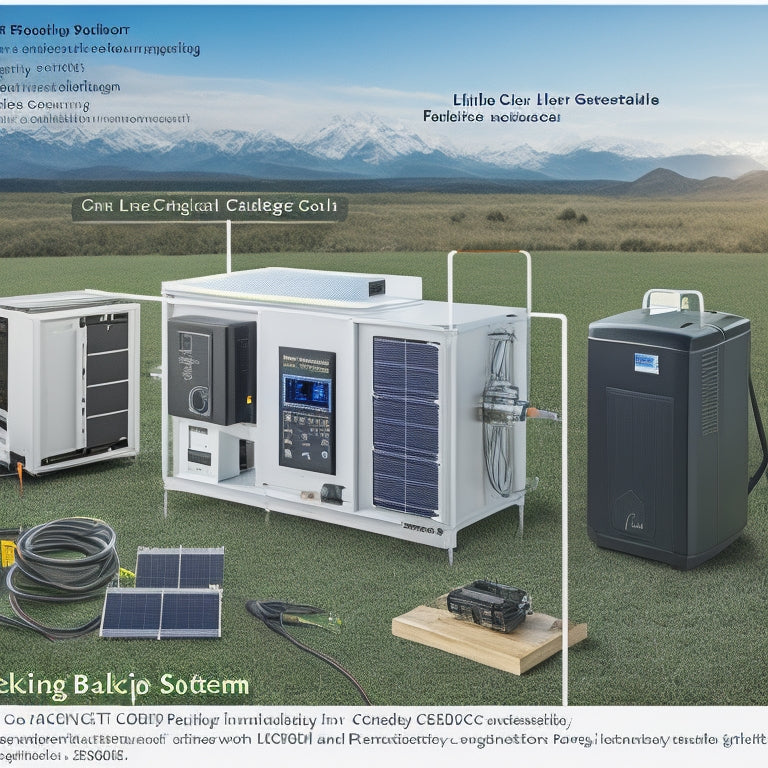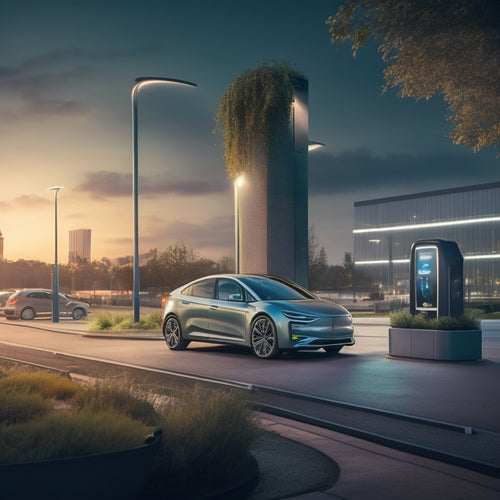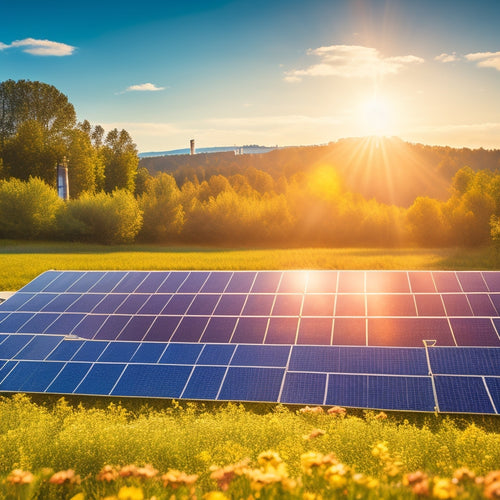
What's Required for Large Home Backup Systems
Share
When designing a large home backup system, you'll need to accurately determine your power needs by identifying critical appliances, calculating total wattage for peak demand, and conducting energy audits. This calculation will inform your selection of suitable battery capacity, efficient inverter technology, and sized solar panel arrays. Additionally, you'll need to guarantee reliable system monitoring, meet electrical code requirements, and plan for scalability and growth. As you traverse these complex components, it's crucial to contemplate every detail to achieve a seamless and efficient backup system that meets your specific needs - and there's more to investigate in achieving peak performance.
Key Takeaways
- Accurately determining power needs is crucial, considering critical appliances, wattage calculation, energy audits, and backup period considerations.
- Selecting suitable battery capacity involves assessing energy storage needs, system autonomy, battery chemistry, and energy requirements during outages.
- Choosing efficient inverter technology is essential, as it affects energy losses, reliability, and maintenance, with high-efficiency inverters being preferred.
- Sizing solar panel arrays correctly involves analyzing energy requirements, peak sun hours, inverter efficiency, and system losses to ensure reliable power supply.
- Implementing a reliable monitoring plan with real-time tracking and proactive management helps detect potential issues early, minimizing downtime and ensuring optimal performance.
Determining Power Needs Accurately
When sizing a large home backup system, your power needs become the critical factor in determining the right system for your property.
To precisely determine your power needs, you'll need to calculate your energy consumption. Start by identifying the essential appliances and devices you want to power during an outage, such as refrigerators, lights, and medical equipment.
Next, calculate the total wattage required to power these items simultaneously, which represents your peak demand. Consider conducting an energy audit to identify inefficiencies and opportunities for energy efficiency upgrades, and focus on maximizing renewable energy investment benefits.
Consider the duration of the backup period and the type of loads you'll be supporting, as these factors will impact your overall energy consumption.
Selecting Suitable Battery Capacity
When selecting a battery for your large home backup system, you'll need to assess the battery size that can adequately support your energy storage needs.
To determine this, conduct an energy audit to identify inefficiencies and improvement opportunities, and factor in all energy-using appliances, evaluating off-grid energy needs.
You must calculate the total watt-hours required to power your critical loads during an outage, considering the system's autonomy and the depth of discharge.
Battery Size Considerations
Determining the suitable battery capacity for your large home backup system requires careful evaluation of several factors, including your energy requirements, the type and number of devices to be powered, and the desired backup duration.
You'll need to calculate your total energy load in watt-hours (Wh) and take into account the battery chemistry, as different types have varying depths of discharge and round-trip efficiencies.
Lithium-ion batteries, for example, can handle higher discharge rates and are more efficient than lead-acid batteries.
You'll also need to take into account the battery's capacity to supply power during peak demand periods.
Energy Storage Needs
Having calculated your total energy load, you're now ready to select a suitable battery capacity that meets your energy storage needs.
To do this, consider the duration you want your backup system to run during an outage. A longer backup time requires a larger battery capacity.
You'll also need to factor in the depth of discharge (DOD), which affects battery life. A higher DOD means more energy is used, reducing battery life.
For energy efficiency, look for batteries with a high round-trip efficiency, as this minimizes energy losses during charging and discharging.
Choosing Efficient Inverter Technology
The heart of a large home backup system lies in its inverter technology, which converts DC power from your battery bank or solar array into usable AC power for your home. You'll need to choose an inverter that efficiently handles the power conversion process.
| Inverter Feature | Efficiency Impact |
|---|---|
| Type (string, micro, etc.) | High |
| Brand (e.g. Schneider, SMA) | Medium |
| Configuration (grid-tie, off-grid) | High |
| Features (e.g. monitoring, grid support) | Low |
| Warranty and Maintenance | Medium |
When selecting an inverter, consider factors like efficiency, type, brand, configuration, features, lifespan, warranties, and maintenance requirements. High-efficiency inverters reduce energy losses, while specific types and brands may better suit your system's needs. Certain configurations and features can impact performance and monitoring capabilities. Finally, look for inverters with thorough warranties and easy maintenance to guarantee long-term reliability.
Sizing Solar Panel Arrays Correctly
When sizing a solar panel array for your large home backup system, you'll need to accurately calculate the array size based on your energy requirements.
To do this, you must analyze your energy needs, considering factors like your backup power goals, load types, and duty cycles.
It's crucial to conduct an energy assessment to determine your historical consumption and potential future energy changes.
Array Size Calculations
You need to calculate the array size correctly to guarantee your solar panel system meets your energy demands. This involves considering several factors, including your energy requirements, solar panel efficiency, and the system's design.
| Factor | Calculation |
|---|---|
| Peak Sun Hours (PSH) | Average daily solar irradiance in your area |
| System Losses | Inverter efficiency, wiring losses, and other losses |
| Backup System Longevity | Desired lifespan of your backup system |
| Energy Requirements | Total energy needed to power your home during an outage |
| Solar Panel Efficiency | Efficiency rating of your solar panels |
Energy Requirements Analysis
During power outages, your backup system must be able to supply all the necessary energy to your home, making accurate energy requirements analysis vital.
To achieve grid independence, you need to determine your energy demands accurately. This involves evaluating your energy efficiency, load management, and peak shaving strategies.
You'll also need to take into account your renewable integration goals and how they impact your energy requirements.
By analyzing your energy usage patterns, you can optimize your system's demand response and minimize its environmental impact.
A thorough energy requirements analysis guarantees your system is sized correctly, providing reliable power during outages while promoting system longevity.
Ensuring Reliable System Monitoring
Setting up a reliable system monitoring plan is key to detecting potential issues before they escalate into major problems.
It's essential that you can track your system's performance in real-time, receiving system alerts when anomalies occur. You'll want to monitor performance metrics such as battery state of charge, fuel levels, and generator runtime.
This data will enable you to identify trends and potential issues before they cause downtime. You should also set up custom alerts for specific events, like high temperature or low battery voltage.
With a strong monitoring system in place, you'll be able to respond quickly to issues, minimizing downtime and ensuring your backup system is always ready when you need it.
Meeting Electrical Code Requirements
Installing a large home backup system requires compliance with local electrical codes and regulations, which vary by region and jurisdiction, but all share the common goal of guaranteeing safe and reliable operation.
You must guarantee that your system meets these requirements to avoid electrical hazards, fines, and even legal action.
To achieve code compliance, you'll need to:
- Hire a licensed electrician to design and install your system
- Pass electrical inspections by local authorities
- Use equipment and materials that meet or exceed code requirements
- Maintain accurate records of installation, testing, and maintenance
Planning for Scalability and Growth
Having confirmed your large home backup system meets electrical code requirements, you're now ready to contemplate the long-term implications of your installation.
As you plan for the future, consider scalability and growth to guarantee your system remains effective and efficient. Future-proofing your system involves selecting components that can adapt to changing energy demands and integrating renewable sources, such as solar or wind power.
This forward-thinking approach enables you to easily add or upgrade components as needed, minimizing costly replacements and maximizing your system's lifespan.
Frequently Asked Questions
Can I Use a Single Inverter for Multiple Solar Panel Arrays?
You can use a single inverter for multiple solar panel arrays if the inverter is compatible with the arrays' diverse electrical characteristics, and its maximum power point tracking (MPPT) capabilities can manage the combined output, ensuring efficient multiple array integration.
Are Lithium-Ion Batteries Safe for Indoor Installation?
You're considering lithium-ion batteries for indoor installation, but you're right to question their safety; while they're generally safe, you'll need to guarantee proper ventilation, thermal management, and compliance with local building codes to mitigate risks.
Do I Need to Upgrade My Electrical Panel for a Backup System?
You'll need to assess your electrical load to determine if your existing panel capacity can handle the added power of a backup system; if not, you'll need to upgrade your electrical panel to guarantee safe and efficient operation.
Can I Use a Generator as a Backup Power Source?
You'll need to evaluate a generator's capacity to match your home's power demands, and choose from fuel options like natural gas, propane, or diesel, ensuring a compatible setup that meets your specific backup power requirements.
Are Whole-Home Backup Systems Compatible With Grid-Tie Systems?
You'll be intrigued to know that 70% of homeowners prioritize backup power during outages. When it comes to whole-home backup systems, you'll find they're compatible with grid-tie systems, provided they guarantee battery compatibility and precise grid synchronization for seamless changes.
Related Posts
-

Solid State Batteries in Electric Vehicles
Solid-state batteries revolutionize electric vehicles by offering a longer lifespan and higher energy density than tr...
-

Advantages of Solar Generating Systems Over Traditional Energy
Solar generating systems provide several key advantages over traditional energy sources. You'll experience lower long...
-

Essential Hiking Lights for Safety and Fun
When you're hitting the trails, essential hiking lights are vital for safety and fun. A lightweight headlamp offers h...


